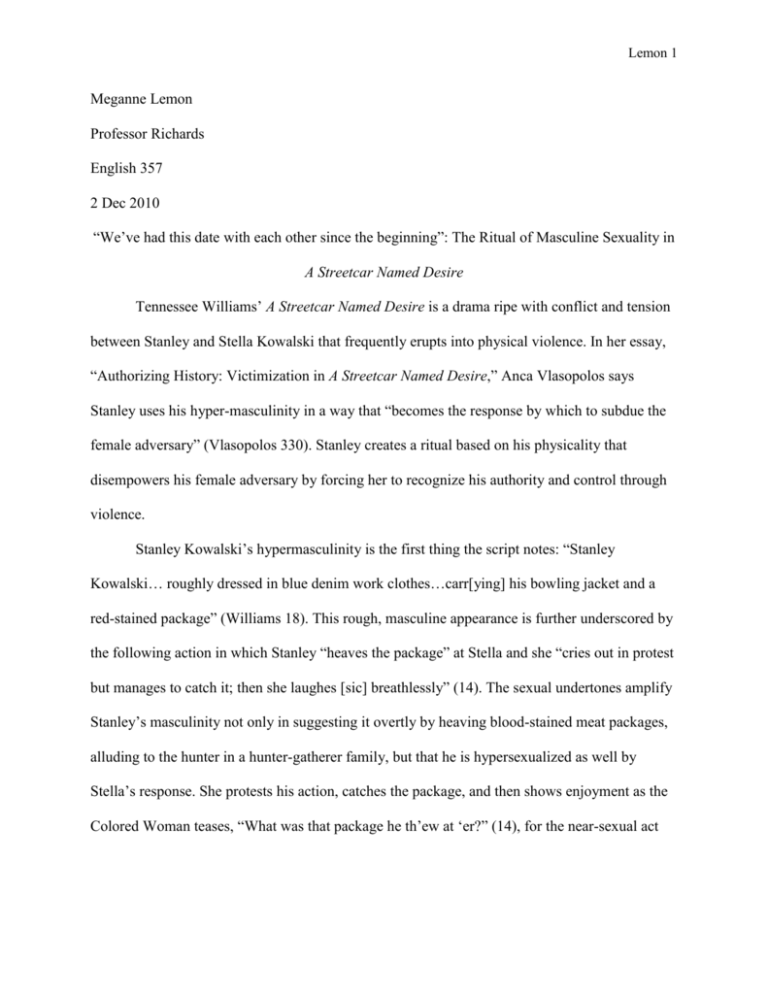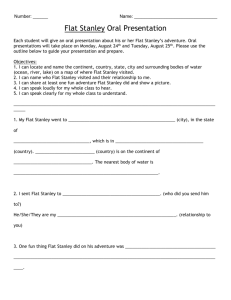Meganne Lemon`s - ENGL 357: Southern Literature
advertisement

Lemon 1 Meganne Lemon Professor Richards English 357 2 Dec 2010 “We’ve had this date with each other since the beginning”: The Ritual of Masculine Sexuality in A Streetcar Named Desire Tennessee Williams’ A Streetcar Named Desire is a drama ripe with conflict and tension between Stanley and Stella Kowalski that frequently erupts into physical violence. In her essay, “Authorizing History: Victimization in A Streetcar Named Desire,” Anca Vlasopolos says Stanley uses his hyper-masculinity in a way that “becomes the response by which to subdue the female adversary” (Vlasopolos 330). Stanley creates a ritual based on his physicality that disempowers his female adversary by forcing her to recognize his authority and control through violence. Stanley Kowalski’s hypermasculinity is the first thing the script notes: “Stanley Kowalski… roughly dressed in blue denim work clothes…carr[ying] his bowling jacket and a red-stained package” (Williams 18). This rough, masculine appearance is further underscored by the following action in which Stanley “heaves the package” at Stella and she “cries out in protest but manages to catch it; then she laughes [sic] breathlessly” (14). The sexual undertones amplify Stanley’s masculinity not only in suggesting it overtly by heaving blood-stained meat packages, alluding to the hunter in a hunter-gatherer family, but that he is hypersexualized as well by Stella’s response. She protests his action, catches the package, and then shows enjoyment as the Colored Woman teases, “What was that package he th’ew at ‘er?” (14), for the near-sexual act Lemon 2 that just happened; Stella enjoys the display of sexuality and masculinity, even in a rather voyeuristic situation. This scene reveals not only Stanley’s desire to force his sexuality onto Stella, but also to show his masculinity. It parallels how Frederick Douglass shows his transition to masculinity and manhood in Narrative of the Life of Frederick Douglass, an American Slave, Written by Himself, saying, “You have seen how a man was made a slave; you shall see how a slave was made a man” (Andrews 47). In her article “In the First Place: Making Frederick Douglass and the Afro-American Narrative Tradition,” Deborah E. McDowell says, in regards to Douglass’ line, that it “equates resistance to power with physical struggle” (McDowell 180). In Streetcar, the opening scene shows the power dynamics existing between Stanley and Stella, suggesting that it could very well come to physical struggle by Stella’s resistance of the package, yet it will end in gratification on both their parts, just like Douglass was gratified by his ability to reject one identity for another. Stanley uses his own ritual to force Stella, and ultimately Blanche, into submission the same way a master used ritualized violence against Douglass to control him. Stanley’s ritual, first shown in Scene One to depict his hypermasculinity, begins when Stanley is with his friends, usually either at a poker game or a bowling league, and drinks. A woman, usually Stella, aggravates him, such as by playing the radio, and scolds his behavior when he tells her off, “Don’t yell at me like that” (Williams 14). This causes Stanley to become even more agitated, reacting with increasing anger that someone removes his- or herself from the situation. The other runs after to apologize and they make up, such as Stella hurrying after Stanley to watch him bowl in Scene One. While Scene One shows this ritual on a smaller scale, the entire ritual shown in Lemon 3 Scene Three suggests Scene One foreshadows a scenario more disturbing for an audience to understand and witness. The ritual of Scene Three begins at the poker game, where Stanley and the men are drinking. Their conversation turns crude the more the men drink. Stanley begins to show his frustration with Stella, “giv[ing] a loud whack of his hand on her thigh” (48), which Stella tells Blanche “makes me so mad when he does that in front of people” (48). He becomes more agitated and Stanley’s rage takes over as he “charges after Stella” (57) and loses his temper, which sends the sisters upstairs for refuge. Stanley realizes Stella left him and he “stumbles half dressed out to the porch and down the wooden steps to the pavement before the building...he throws back his head like a baying hound and bellows his wife’s name: ‘Stella! Stella, sweetheart! Stella!’” (59). This display of passionate apology, during which Stanley is soaking wet and half-dressed, once again referencing his hypermasculinity, culminates in a sexuallycharged act of forgiveness: “Stella slips down the rickety stairs in her robe. Her eyes are glistening with tears and her hair loose about her throat and shoulders. They stare at each other. Then they come together with low, animal moans” (60). As the primary ritual, this shows an increase in Stanley’s use of violence to achieve control and explains why he uses sex as a marker of completion. A previous incident shows Stanley just as hypermasculine but not as violent. While his anger may be related to Stella’s behavior, Stanley instead directs his anger towards the light bulbs, smashing them with her slippers. However, Vlasopolos says, “violence against inanimate objects foreshadows later victimization”; this later victimization happens when Stanley tries to use this ritual to control Blanche and reveals a disturbing increase in the violence needed to ensure his ritual remains intact (Vlasopolos 328). Lemon 4 That the smashing of the lightbulbs happens on their wedding night reveals Stanley as cognizant of how Stella responds to his anger, violence, and masculinity. Stella tells Blanche, “I was—sort of—thrilled by it” (Williams 64), which suggests that Stanley plays up his hypermasculinity in order to provoke the animalistic response from Stella for two reasons. First, Stanley knows that as long as he apologizes through sex, Stella will not leave him, as she tells Blanche, because “there are things that happen between a man and a woman in the dark—that sort of make everything else seem—unimportant” (70). Second, the sex works in Stanley’s favor because it restores his masculinity. Her fleeing the apartment, a removal from the domestic space that only men should be capable of in the late 1940s, emasculates him. McDowell argues that “’masculinity’ was restored by putting…women in their proper ‘feminine’ place” (McDowell 173). Because Stanley immediately takes Stella to bed as part of the apology process, it reinforces his control over Stella and forces her to recognize his authority by literally putting her underneath him. Unlike Stella who actively participates in Stanley’s ritual, Blanche refuses to. In Stanley’s first attempt to elicit her participation, he goes through her trunk. Stanley and Stella argue about Blanche’s “treasure chest of a pirate” (Williams 36) stocked with “pearls! Ropes of them…bracelets of solid gold, too…and diamonds!” (36). As per the ritual, Stella removes herself, “go[ing] out to the porch” (37), but Blanche enters, causing a slight deviation for Stanley as it enables him to shift control from his wife to her sister and assert his ritual over Blanche. Rather than getting angry as Stella would, Blanche simply remarks “it looks like my trunk has exploded” (38). Stanley tries provoking Blanche into an animalistic fury that he does Stella, yet she does not fall for it. She talks Stanley out of his anger by proving his foolishness over mortgage papers which he tries to rectify by invoking authority, saying, “You see, under the Lemon 5 Napoleonic code—a man has to take an interest in his wife’s affairs” (43), rather than resorting to his tried and proven method of using his hypermasculinity as a way to control women. Because Blanche’s “increasing dissent makes Stanley try even harder to keep control,” it causes him to deviate from his ritual as Douglass forces his master to deviate from his ritual of dehumanization (Vlasopolos 330). Thus, Stanley must respond more sinisterly to maintain control. In Scene Ten, Stanley’s ritualized sexuality conflicts with Blanche even more so that in order for him to control her appropriately as he manages Stella, he must force his masculinity and sexuality onto her in Streetcar’s most violent scene. Stanley proposes, “Shall we bury the hatchet and make it a loving-cut?” (Williams 125). They begin drinking yet it turns violent as Stanley corners Blanche in the bedroom despite her protesting “some awful thing will happen” (130) and “they have some rough-house” (130). That Stanley has to rape Blanche in order to complete the ritual that began earlier is incredibly disturbing. Not only does the rape reveal how far Stanley is willing to go in order to make Blanche recognize his authority, but also because Stanley reveals to Blanche that “We’ve had this date with each other from the beginning” (130). Stanley intentionally planned to achieve some sort of gratification from Blanche regardless of participation, actively or passively, because he derives pleasure from this ritual in order to satiate his hypermasculinity, which McDowell says “constitutes his ‘stylistic signature’ and expresses his ‘performing self’” (McDowell 177). Stanley relies on this ritual for attaining sexual gratification and retaining control far too much that it becomes his signature and forces him to behave only as the ritual allows. Like the ritual was used as the opening, the ritual is used to end the play in Scene Eleven. Stanley and Stella argue over Blanche’s institutionalization but it is unclear if Stanley is able to follow through as now Stella has their newborn son to care for. In Scene Eleven, we see not only Lemon 6 Stanley beginning to reassert his control over Stella as he murmurs “Now, honey. Now, love. Now, now, love” (Williams 142) and “kneels beside her…his fingers find the opening of her blouse” (142), but also Baby Kowalski beginning to assert his control over Stella through nursing and her maternity. This last image can, and ought to, be further explored in future studies of power dynamics in Streetcar as it considers the idea that men are groomed from infancy to ritualize their control over women. Further study can also include analysis of Marlon Brando’s performance in the 1951 film as Stanley. His performance takes the character’s desire for ritual to extremes that enhance Williams’ characterization, demanding more recognition that masculinity and sexuality create a dangerous ritual that forces female disempowerment and submission, sometimes necessitating the removal of female presence entirely. Lemon 7 Works Cited Andrews, William L. and McFeely, William S., ed. Narrative of the Life of Frederick Douglass, an American Slave, Written by Himself. New York: WW Norton and Company, 1997. McDowell, Deborah E. “In the First Place: Making Frederick Douglass and the Afro-American Narrative Tradition.” Ed. William L. Andrews and William S. McFeely. Narrative of the Life of Frederick Douglass, an American Slave, Written by Himself. New York: WW Norton and Company, 1997. 172-183. Vlasopolos, Anca. “Authorizing History: Victimization in A Streetcar Named Desire.” Theatre Journal 38.2 (1986): 322-388. JSTOR. 3 Nov 2010. Williams, Tennessee. A Streetcar Named Desire. New York: Signet, 1980.





